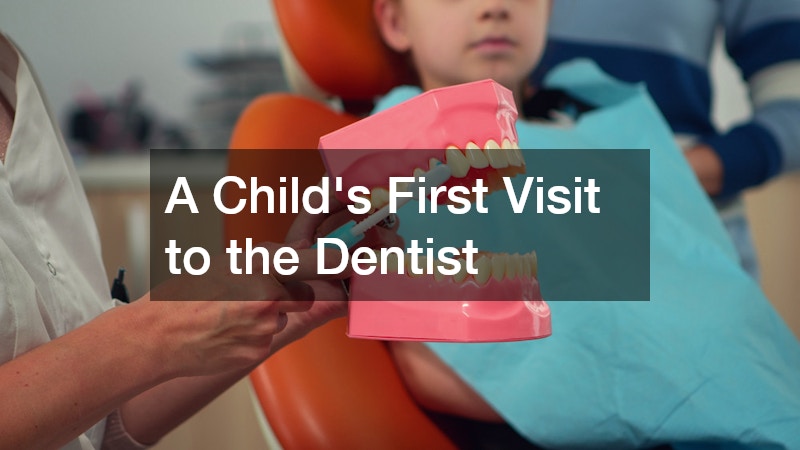A child’s first visit to the dentist is a milestone moment in their journey toward lifelong oral health. For many parents, it can be both exciting and nerve-wracking. They want to ensure that their child feels comfortable and confident while learning the importance of caring for their teeth.
The goal of that first appointment is not only to check on the child’s dental development but also to build a foundation of trust and positive experiences.
From the moment a child enters the dental office, the environment plays a huge role in setting the tone. Pediatric dental offices are designed to feel bright, friendly, and inviting, often decorated with colorful murals, toys, or games to keep children entertained. This fun setting helps reduce fear and replaces anxiety with curiosity. The sounds and smells that might be intimidating in a typical dental clinic are softened by the cheerful energy of a space created just for kids.
When meeting the dentist for the first time, children often take their cues from their parents. If the parent appears calm and upbeat, the child is more likely to feel at ease. Before the visit, parents can talk to their child about what will happen in simple, reassuring terms. Saying things like, “The dentist will count your teeth and make them sparkle clean” helps the child see it as something fun instead of scary. Avoiding negative words such as “hurt” or “shot” can also make a big difference in shaping expectations.
The first dental visit usually takes place around the time the child turns one year old or when their first teeth appear. At this age, the dentist is primarily focused on introducing the child to the environment and giving parents guidance on how to care for those new teeth. The dentist will gently examine the mouth, checking for proper tooth eruption, early signs of decay, and gum health. They may also discuss feeding habits, thumb sucking, or pacifier use—all of which can influence the development of healthy teeth and jaws.
The experience is typically quick and lighthearted. The child may sit on a parent’s lap, and the dentist may use small mirrors and tools to take a brief look inside the mouth. This “lap to lap” exam allows the child to stay comfortable while getting used to being examined. Many pediatric dentists even give small prizes, stickers, or toothbrushes at the end, turning the appointment into a rewarding adventure.
Education is another key part of the first visit. Parents often receive helpful advice on brushing techniques, the right type of toothbrush and toothpaste, and how to build healthy eating habits that prevent cavities. The dentist may demonstrate brushing on a model or the child’s own teeth, showing the correct circular motion and reminding both parent and child to brush for two minutes twice a day. Topics like fluoride use, proper rinsing, and flossing might also come up as part of long-term care discussions.
Beyond the technical aspects, the first dental visit is about building relationships. The child learns to see the dentist not as someone to fear but as a friendly helper who keeps their smile healthy. This early trust can prevent anxiety during future visits and encourage regular checkups throughout life. Establishing a routine of seeing the dentist every six months helps detect any potential problems early, avoiding more complex treatments later on.
Parents can prepare for the first appointment by scheduling it for a time when their child is usually well-rested and in a good mood. Bringing along a favorite toy or blanket can provide extra comfort. It is also wise to arrive a few minutes early so the child can explore the waiting area and acclimate to the surroundings before being called in. Some parents read storybooks or watch short videos about visiting the dentist beforehand, turning the idea into something familiar and positive.
After the appointment, celebrating the child’s bravery reinforces good behavior. Complimenting them on how well they did and letting them choose a small reward—like a trip to the park or an extra bedtime story—creates positive associations. This approach helps the child look forward to future dental visits rather than dreading them.
As children grow, these early experiences shape how they approach self-care. A good relationship with a dentist helps build lifelong habits of brushing, flossing, and maintaining regular appointments. It also gives children confidence in taking charge of their health. When dental care is normalized early, kids are more likely to prioritize it as they get older.
The long-term benefits extend beyond just clean teeth. Good oral health is linked to better overall well-being. Preventing cavities, gum disease, and alignment problems in childhood can save families from more serious health issues later. Plus, a confident smile boosts self-esteem, especially as children begin social interactions at school and in other activities.
In short, a child’s first visit to the dentist sets the stage for a lifetime of healthy smiles. It is more than a quick checkup—it is an introduction to a partnership that nurtures trust, knowledge, and confidence. By approaching it with positivity, preparation, and patience, parents can help their children form strong, happy habits that last well into adulthood.

